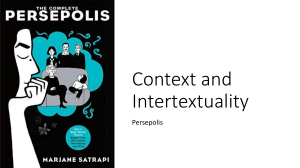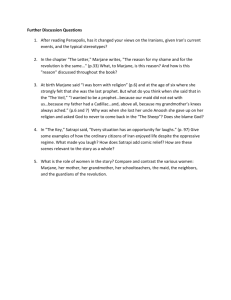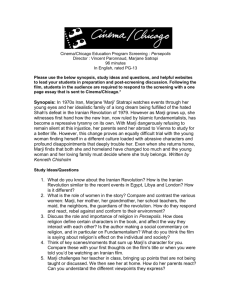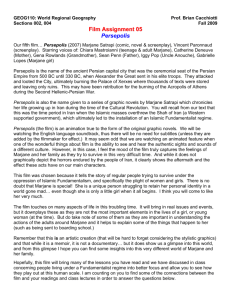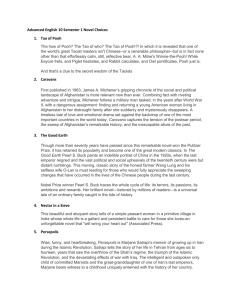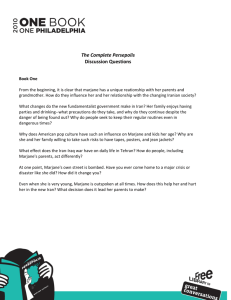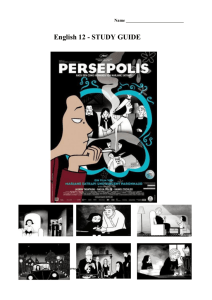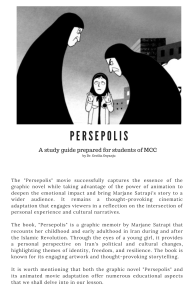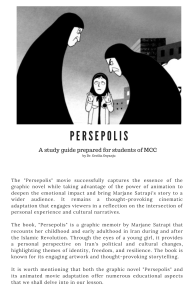Paper on Persepolis: Graphic Autobiography and Film
advertisement
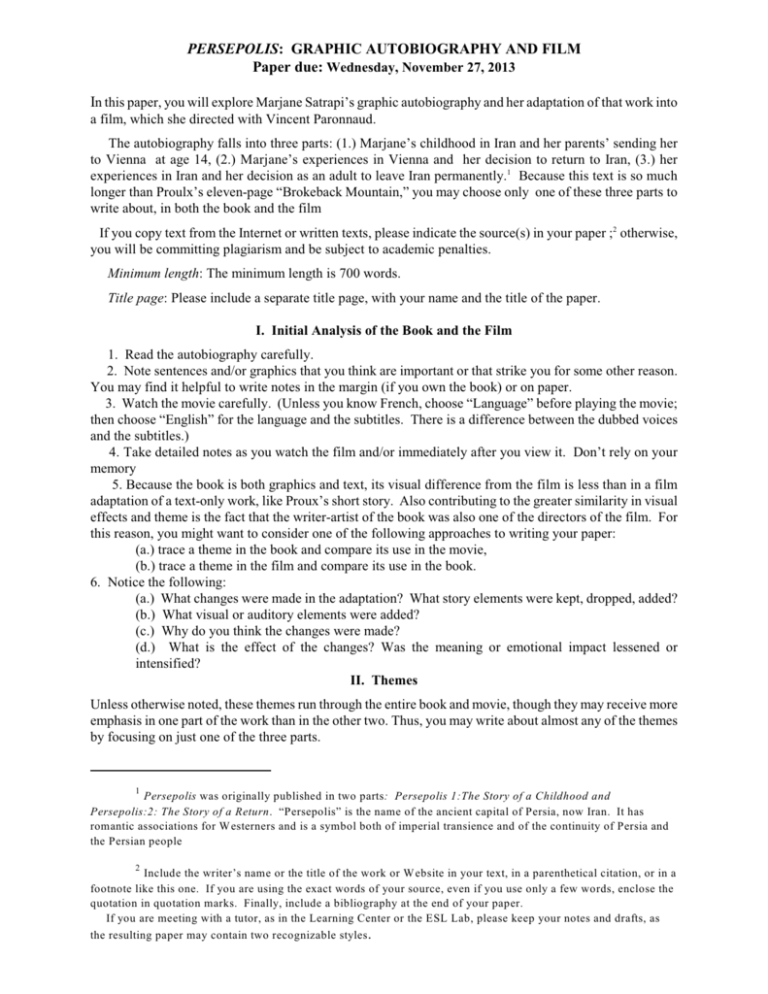
PERSEPOLIS: GRAPHIC AUTOBIOGRAPHY AND FILM Paper due: Wednesday, November 27, 2013 In this paper, you will explore Marjane Satrapi’s graphic autobiography and her adaptation of that work into a film, which she directed with Vincent Paronnaud. The autobiography falls into three parts: (1.) Marjane’s childhood in Iran and her parents’ sending her to Vienna at age 14, (2.) Marjane’s experiences in Vienna and her decision to return to Iran, (3.) her experiences in Iran and her decision as an adult to leave Iran permanently.1 Because this text is so much longer than Proulx’s eleven-page “Brokeback Mountain,” you may choose only one of these three parts to write about, in both the book and the film If you copy text from the Internet or written texts, please indicate the source(s) in your paper ;2 otherwise, you will be committing plagiarism and be subject to academic penalties. Minimum length: The minimum length is 700 words. Title page: Please include a separate title page, with your name and the title of the paper. I. Initial Analysis of the Book and the Film 1. Read the autobiography carefully. 2. Note sentences and/or graphics that you think are important or that strike you for some other reason. You may find it helpful to write notes in the margin (if you own the book) or on paper. 3. Watch the movie carefully. (Unless you know French, choose “Language” before playing the movie; then choose “English” for the language and the subtitles. There is a difference between the dubbed voices and the subtitles.) 4. Take detailed notes as you watch the film and/or immediately after you view it. Don’t rely on your memory 5. Because the book is both graphics and text, its visual difference from the film is less than in a film adaptation of a text-only work, like Proux’s short story. Also contributing to the greater similarity in visual effects and theme is the fact that the writer-artist of the book was also one of the directors of the film. For this reason, you might want to consider one of the following approaches to writing your paper: (a.) trace a theme in the book and compare its use in the movie, (b.) trace a theme in the film and compare its use in the book. 6. Notice the following: (a.) What changes were made in the adaptation? What story elements were kept, dropped, added? (b.) What visual or auditory elements were added? (c.) Why do you think the changes were made? (d.) What is the effect of the changes? Was the meaning or emotional impact lessened or intensified? II. Themes Unless otherwise noted, these themes run through the entire book and movie, though they may receive more emphasis in one part of the work than in the other two. Thus, you may write about almost any of the themes by focusing on just one of the three parts. 1 Persepolis was originally published in two parts: Persepolis 1:The Story of a Childhood and Persepolis:2: The Story of a Return. “Persepolis” is the name of the ancient capital of Persia, now Iran. It has romantic associations for Westerners and is a symbol both of imperial transience and of the continuity of Persia and the Persian people 2 Include the writer’s name or the title of the work or W ebsite in your text, in a parenthetical citation, or in a footnote like this one. If you are using the exact words of your source, even if you use only a few words, enclose the quotation in quotation marks. Finally, include a bibliography at the end of your paper. If you are meeting with a tutor, as in the Learning Center or the ESL Lab, please keep your notes and drafts, as the resulting paper may contain two recognizable styles . • Marjane’s development from childhood into womanhood Influence of her family Her grandmother tells her, “Always keep your dignity and be true to yourself” (“The Dowry”). She remembers this advice in “The Vegetables” in part 2. Influence of school and classmates/friends Societal influence, e.g., the wars, the revolution, the threat of arrest and imprisonment Her relationships with men (this occurs mainly in parts 2 and 3). • The use of the child’s point of view in part 1, the adolescent’s in part 2, the young adult’s in part 3 • Love of country and being Iranian Iranian society survives invasions (Arab, Mongol) and oppression and continues to be Iranian. Marji struggles to develop an identity that includes being an individual and an Iranian. Anoosh tells her his history to keep family memory continuing, Her father tells her, “Don’t ever forget who you are and where you come from” (The Dowry”). Marjane’s conflict between the desire to fit in and being Iranian becomes an issue in parts 2 and 3. • Marjane as rebel and her struggle to be her own person • Modernity versus tradition Marji hides wanting to be a prophet from her progressive parents. She’s conflicted over the veil, being religious deep down and living with a modern family. • The importance of family and relationships within the family Marjane’s relationship with her father, her mother, her grandmother and their effect on her Her relationship with Uncle Anoosh and his effect on her The contradictions between family life and public life after the Islamic Revolution • The stories adults tell Marji affect her behavior immediately and her development into and as an adult. Her father tells the history of how the king was not chosen by God and that her grandfather was the last Qadjar emperor (“The Water Cell”). Her mother tells of her father’s imprisonment (“The Water Cell”). Her grandmother tells of her husband’s imprisonment and the Shah(“Persepolis”). Her father tells about the crowd and widow calling a man who died of cancer a martyr (“Persepolis”). Siamik and Moshen describe their tortures in prison (“The Heroes”). Uncle Anoosh recounts the history of his life and his uncle Fereydoon (“Moscow”). Her cousin Shahab tells of the front and the heavy casualties among the young recruits (“The Key”). Her childhood friend Kia tells her a soldier’s joke involving dismemberment (“The Joke,” part 3). • Social class Marjane’s family and their friends are Marxists/Communists who support the working class taking power and eliminating the class difference, yet there are contradictions between their ideals and lives. Marji’s family is privileged, upper middle-class (her father drives a Cadillac), as are their friends. Her great grandfather was the last Qadjar emperor of Iran; her great-uncle helped found Azerbajan, Her father’s attitude toward the romance of Mehri, the maid, and Hossein, the neighbor, is classist.. The maid eats by herself, not with the family, and began working at age 8. Her radical parents, Anoosh, and their friends have a condescending attitude toward the lower classes. • The treatment and role of women in Iran, particularly after the Islamic Revolution Consider her mother, grandmother, teachers, the maid, her classmates, the neighbors, the Guardians of the Revolution (female division). • Portrayal of Iran She wants to humanize Iran to Westerners, to correct Western mis-perceptions, Does she succeed? • Portrayal of Islam Is she critical of Islam or of the fundamentalist Islam which governs Iran after the Islamic Revolution? Does she convincingly show the similarities of Western and Islamic societies? • The horrors of war: the Islamic Revolution of 1979.and the external war with Iraq (1980-1988) The Shah is unpopular with and overthrown by secular leftists and by religious fundamentalists. Political/religious manipulation of citizens (e.g., elevation of martyrs and heroes) The violence and the deaths • “Freedom had a price” is the last line of the book and almost the last line of the movie.
